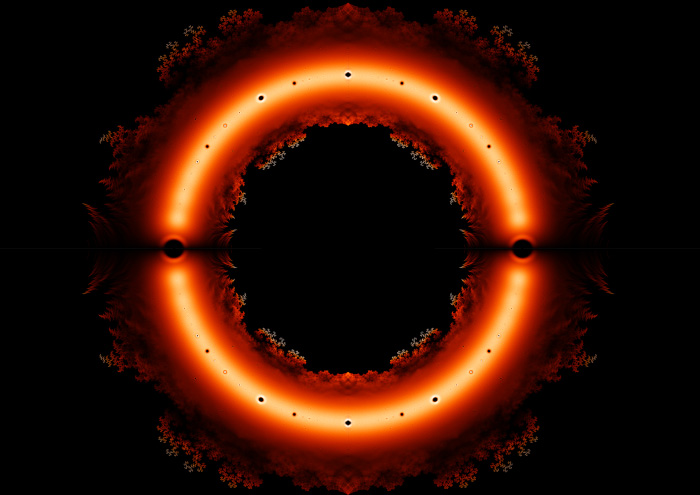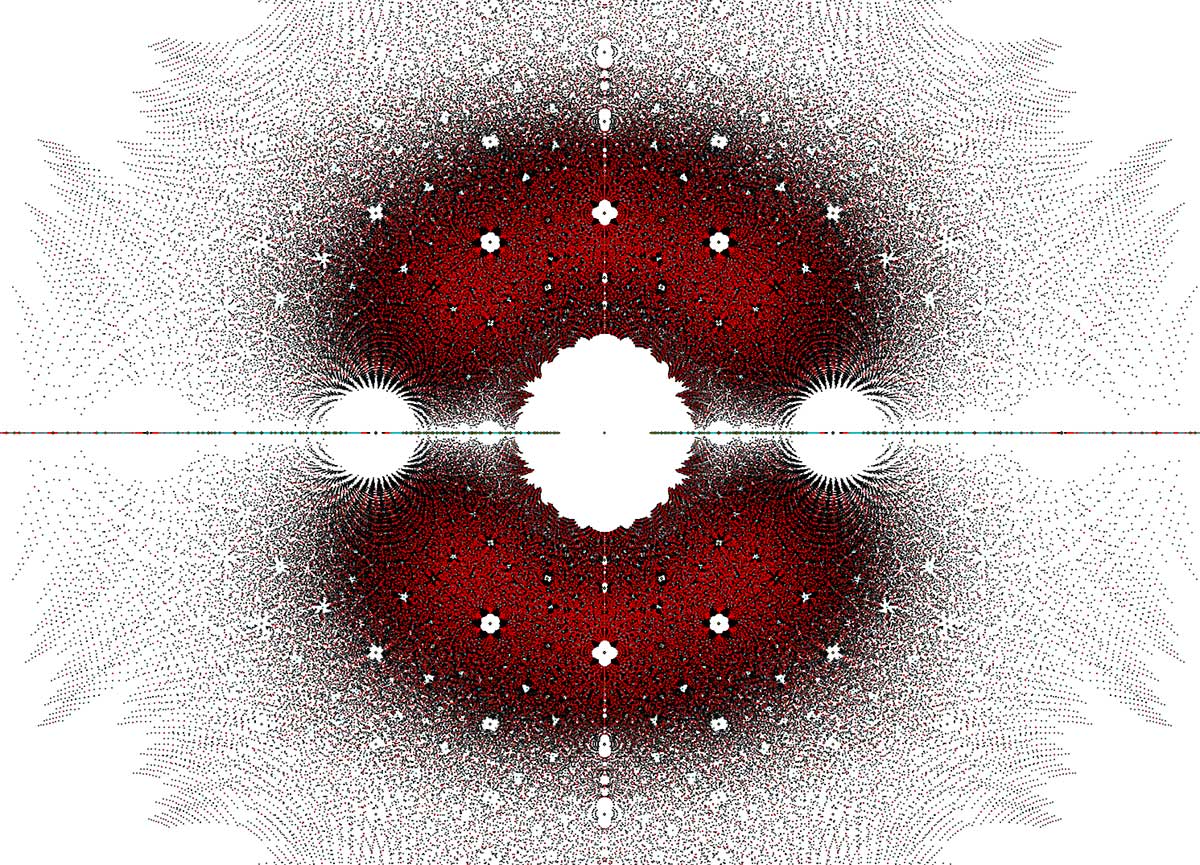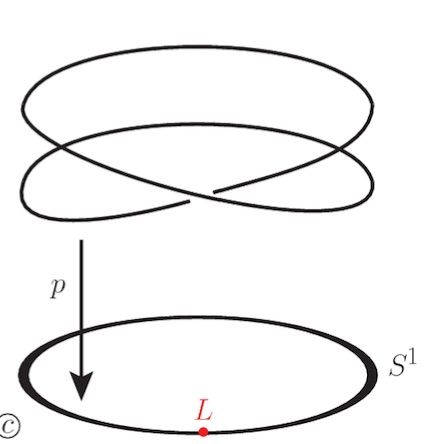Some weeks ago, Robert Kucharczyk and Peter Scholze found a topological realisation of the ‘hopeless’ part of the absolute Galois group $\mathbf{Gal}(\overline{\mathbb{Q}}/\mathbb{Q})$. That is, they constructed a compact connected space $M_{cyc}$ such that etale covers of it correspond to Galois extensions of the cyclotomic field $\mathbb{Q}_{cyc}$. This gives, at least in theory, a handle on the hopeless part of the Galois group $\mathbf{Gal}(\overline{\mathbb{Q}}/\mathbb{Q}_{cyc})$, see the previous post in this series.
Here, we will get halfway into constructing $M_{cyc}$. We will try to understand the topology of the prime ideal spectrum $\mathbf{Spec}(\mathbb{C}[\overline{\mathbb{Q}}^{\times}])$ of the complex group algebra of the multiplicative group $\overline{\mathbb{Q}}^{\times}$ of all non-zero algebraic numbers.
[section_title text=”Pontryagin duals”]
Take an Abelian locally compact group $A$ (for example, an Abelian group equipped with the discrete topology), then its Pontryagin dual $A^{\vee}$ is the space of all continuous group morphisms $A \rightarrow \mathbb{S}^1$ to the unit circle $\mathbb{S}^1$ endowed with the compact open topology.
There are these topological properties of the locally compact group $A^{\vee}$:
– $A^{\vee}$ is compact if and only if $A$ has the discrete topology,
– $A^{\vee}$ is connected if and only if $A$ is a torsion free group,
– $A^{\vee}$ is totally disconnected if and only if $A$ is a torsion group.
If we take the additive group of rational numbers with the discrete topology, the dual space $\mathbb{Q}^{\vee}$ is the one-dimensional solenoid

It is a compact and connected group, but is not path connected. In fact, it path connected components can be identified with the finite adele classes $\mathbb{A}_f/\mathbb{Q} = \widehat{\mathbb{Z}}/\mathbb{Z}$ where $\widehat{\mathbb{Z}}$ is the ring of profinite integers.
Keith Conrad has an excellent readable paper on this fascinating object: The character group of $\mathbb{Q}$. Or you might have a look at this post.
[section_title text=”The multiplicative group of algebraic numbers”]
A torsion element $x$ in the multiplicative group $\overline{\mathbb{Q}}^{\times}$ of all algebraic numbers must satisfy $x^N=1$ for some $N$ so is a root of unity, so we have the exact sequence of Abelian groups
$0 \rightarrow \pmb{\mu}_{\infty} \rightarrow \overline{\mathbb{Q}}^{\times} \rightarrow \overline{\mathbb{Q}}^{\times}_{tf} \rightarrow 0$
where the last term is the maximal torsion-free quotient of $\overline{\mathbb{Q}}^{\times}$. By Pontryagin duality this gives us an exact sequence of compact topological groups
$0 \rightarrow (\overline{\mathbb{Q}}^{\times}_{tf})^{\vee} \rightarrow (\overline{\mathbb{Q}}^{\times})^{\vee} \rightarrow \pmb{\mu}^{\vee}_{\infty} \rightarrow 0$
Here, the left-most space is connected and $\pmb{\mu}^{\vee}_{\infty}$ is totally disconnected. That is, the connected components of $(\overline{\mathbb{Q}}^{\times})^{\vee}$ are precisely the translates of the connected subgroup $(\overline{\mathbb{Q}}^{\times}_{tf})^{\vee}$.
[section_title text=”Prime ideal spectra”]
The short exact sequence of Abelian groups gives a short exact sequence of the corresponding group schemes
$0 \rightarrow \mathbf{Spec}(\mathbb{C}[\overline{\mathbb{Q}}^{\times}_{tf}]) \rightarrow \mathbf{Spec}(\mathbb{C}[\overline{\mathbb{Q}}^{\times}] \rightarrow \mathbf{Spec}(\mathbb{C}[\pmb{\mu}_{\infty}]) \rightarrow 0$
The torsion free abelian group $\overline{\mathbb{Q}}^{\times}_{tf}$ is the direct limit $\underset{\rightarrow}{lim}~M_i$ of finitely generated abelian groups $M_i$ and as the corresponding group algebra $\mathbb{C}[M_i] = \mathbb{C}[x_1,x_1^{-1},\cdots, x_k,x_k^{-1}]$, we have that $\mathbf{Spec}(\mathbb{C}[M_i])$ is connected. But then this also holds for
$\mathbf{Spec}(\mathbb{C}[\overline{\mathbb{Q}}^{\times}_{tf}]) = \underset{\leftarrow}{lim}~\mathbf{Spec}(\mathbb{C}[M_i])$
The underlying group of $\mathbb{C}$-points of $\mathbf{Spec}(\mathbb{C}[\pmb{\mu}_{\infty}])$ is $\pmb{\mu}_{\infty}^{\vee}$ and is therefore totally disconnected. But then we have
$\pi_0(\mathbf{Spec}(\mathbb{C}[\overline{\mathbb{Q}}^{\times}]) \simeq \pi_0(\mathbf{Spec}(\mathbb{C}[\pmb{\mu}_{\infty}]) \simeq \pmb{\mu}_{\infty}^{\vee}$
and, more importantly, for the etale fundamental group
$\pi_1^{et}(\mathbf{Spec}(\mathbb{C}[\overline{\mathbb{Q}}^{\times}],x) \simeq \pi_1^{et}(\mathbf{Spec}(\mathbb{C}[\overline{\mathbb{Q}}^{\times}_{tf}],y)$
So, we have to compute the latter one. Again, write the torsion-free quotient as a direct limit of finitely generated torsion-free Abelian groups and recall that connected etale covers of $\mathbf{Spec}(\mathbb{C}[M_i])=\mathbf{Spec}(\mathbb{C}[x_1,x_1^{-1},\cdots,x_k,x_k^{-1}])$ are all of the form $\mathbf{Spec}(\mathbb{C}[N])$, where $N$ is a subgroup of $M_i \otimes \mathbb{Q}$ that contains $M_i$ with finite index (that is, adjoining roots of the $x_i$).
Again, this goes through the limit and so a connected etale cover of $\mathbf{Spec}(\mathbb{C}[\overline{\mathbb{Q}}^{\times}_{tf}])$ would be determined by a subgroup of the $\mathbb{Q}$-vectorspace $\overline{\mathbb{Q}}^{\times}_{tf} \otimes \mathbb{Q}$ containing $\overline{\mathbb{Q}}^{\times}_{tf}$ with finite index.
But, $\overline{\mathbb{Q}}^{\times}_{tf}$ is already a $\mathbb{Q}$-vectorspace as we can take arbitrary roots in it (remember we’re using the multiplicative structure). That is, $\mathbf{Spec}(\mathbb{C}[\overline{\mathbb{Q}}^{\times}])$ is simply connected!
[section_title text=”Bringing in the Galois group”]
Now, we’re closing in on the mysterious space $M_{cyc}$. Clearly, it cannot be the complex points of $\mathbf{Spec}(\mathbb{C}[\overline{\mathbb{Q}}^{\times}])$ as this has no proper etale covers, but we still have to bring the Galois group $\mathbf{Gal}(\overline{\mathbb{Q}}/\mathbb{Q}_{cyc})$ into the game.
The group algebra $\mathbb{C}[\overline{\mathbb{Q}}^{\times}]$ is a commutative and cocommutative Hopf algebra, and all the elements of the Galois group act on it as Hopf-automorphisms, so it is natural to consider the fixed Hopf algebra
$H_{cyc}=\mathbb{C}[\overline{\mathbb{Q}}^{\times}]^{\mathbf{Gal}(\overline{\mathbb{Q}}/\mathbb{Q}_{cyc})}$
This Hopf algebra has an interesting alternative description as a subalgebra of the Witt ring $W(\mathbb{Q}_{cyc})$, bringing it into the realm of $\mathbb{F}_1$-geometry.
This ring of Witt vectors has as its underlying set of elements $1 + \mathbb{Q}_{cyc}[[t]]$ of formal power series in $\mathbb{Q}_{cyc}[[t]]$. Addition on this set is defined by multiplication of power series. The surprising fact is that we can then put a ring structure on it by demanding that the product $\odot$ should obey the rule that for all $a,b \in \mathbb{Q}_{cyc}$ we have
$(1-at) \odot (1-bt) = 1 – ab t$
In this mind-boggling ring the Hopf algebra $H_{cyc}$ is the subring consisting of all power series having a rational expression of the form
$\frac{1+a_1t+a_2t^2+ \cdots + a_n t^n}{1+b_1 t + b_2 t^2 + \cdots + b_m t^m}$
with all $a_i,b_j \in \mathbb{Q}_{cyc}$.
We can embed $\pmb{\mu}_{\infty}$ by sending a root of unity $\zeta$ to $1 – \zeta t$, and then the desired space $M_{cyc}$ will be close to
$\mathbf{Spec}(H_{cyc} \otimes_{\mathbb{Z}[\pmb{\mu}_{\infty}]} \mathbb{C})$
but I’ll spare the details for another time.
In case you want to know more about the title-picture, quoting from John Baez’ post The Beauty of Roots:
“Sam Derbyshire decided to to make a high resolution plot of some roots of polynomials. After some experimentation, he decided that his favorite were polynomials whose coefficients were all 1 or -1 (not 0). He made a high-resolution plot by computing all the roots of all polynomials of this sort having degree ≤ 24. That’s $2^{24}$ polynomials, and about $24 \times 2^{24}$ roots — or about 400 million roots! It took Mathematica 4 days to generate the coordinates of the roots, producing about 5 gigabytes of data.”



 Let’s look at a finite field $\mathbb{F}_p$. Here, Galois extensions of $\mathbb{F}_p$ (and there is just one such extension of degree $n$, upto isomorphism) correspond to connected etale covers of the circle $S^1$.
Let’s look at a finite field $\mathbb{F}_p$. Here, Galois extensions of $\mathbb{F}_p$ (and there is just one such extension of degree $n$, upto isomorphism) correspond to connected etale covers of the circle $S^1$.